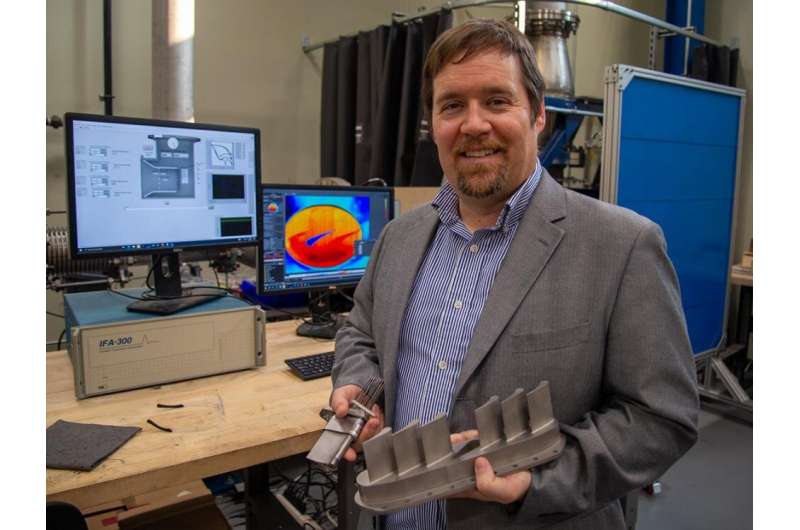This article has been reviewed according to Science X's editorial process and policies. Editors have highlighted the following attributes while ensuring the content's credibility:
fact-checked
trusted source
proofread
3D-printed ceramics may increase gas turbine fuel efficiency, researchers report

Airplane engines can reach temperatures of more than 3,000 degrees Fahrenheit. The hotter they get, the more fuel efficient they become, but that efficiency is limited by how hot the metallic components inside the turbine can get without deforming.
A team that includes Penn State researchers recently 3D printed a turbine component with ceramics, which are more heat tolerant than the conventional metals. The resulting component has complex internal cooling features that enable it to withstand higher temperatures and, as a result, increase fuel efficiency.
The researchers will present their methods and results at the ASME 2023 Turbomachinery Technical Conference and Exposition, which will be held June 26–30 in Boston. Their work will be published in the conference's proceedings and was also recommended for publication in the ASME Journal of Turbomachinery.
"There is a fair amount of research on ceramic materials for gas turbines, but not a lot of it has generated realistically shaped parts because the manufacturing is so difficult to do," said paper co-author Stephen Lynch, associate professor of mechanical engineering at Penn State. "This process was unique in that we could generate complex-shaped parts very easily and very cheaply."
The researchers used design optimization and a novel technique for 3D printing—also known as additive manufacturing—more heat-resistant airfoils using a polymer-derived ceramic material. These turbine components are petal-shaped blades that constantly redirect the hot gas inside the gas turbine engine to extract energy. This energy is used partially to power the rest of the engine, and the rest becomes thrust for an aircraft or power to turn an electric generator.
"We worked with collaborators at the Colorado School of Mines and the University of Wyoming who had embedded ceramic fibers into additively printed ceramics," Lynch said, explaining that these polymer-derived ceramics are created by firing a plastic-like base in a furnace. "We adapted that to create these turbine airfoils, but also leveraged the design freedom of additive manufacturing to create internal features that dramatically improve the effectiveness of the cooling air inside the blade."
By using 3D printing in conjunction with the polymer-derived ceramics, the researchers were able to create the exact shapes needed to withstand more heat and perform well in the gas turbines. The team tested the parts in Penn State's high speed cascade facility, housed in the Steady Thermal Aero Research Turbine Lab.
"We found that with the right design for the part, the ceramic airfoil shape that we 3D printed can perform just as well as the metal components," Lynch said. "Our hope is that this technology could be used to develop ceramic parts that perform similarly to metallic parts in gas turbine engines but can tolerate higher temperatures for greater fuel efficiency."
More information: Design and Cooling Performance of Additively Manufactured Ceramic Turbine Vanes. asme-turboexpo.secure-platform … 4/application/104059



















